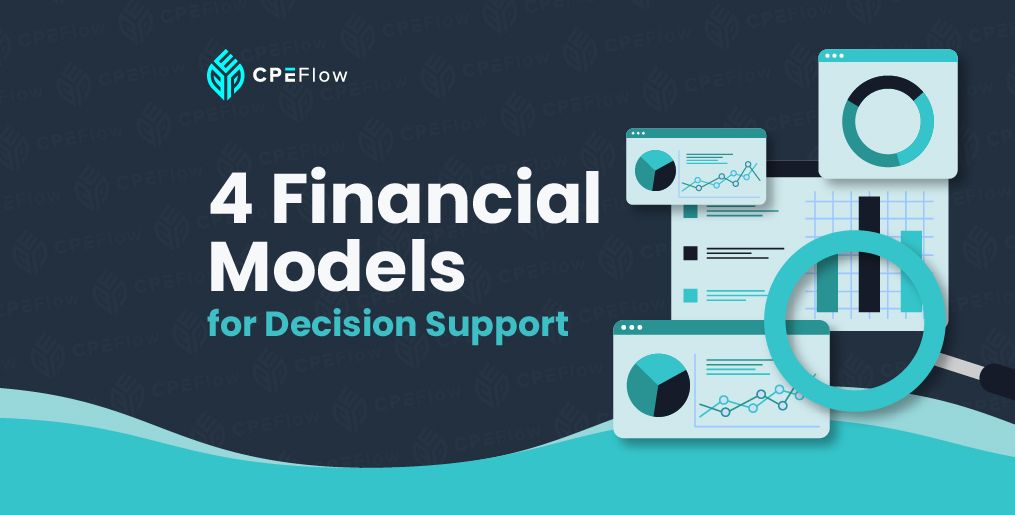4 Financial Models for Decision Support
Nov 11
/
Nathan Liao, CMA

When businesses make pivotal decisions, relying on a magic ball to foresee the future isn't an option. Companies can't afford to take shots in the dark, and this is where financial modeling comes into the picture.
Think of financial modeling as a business's weather forecast. Meteorologists use advanced techniques to measure atmospheric conditions—such as pressure, humidity, wind speeds, and direction—to make more informed predictions. Similarly, financial modeling draws from a business's financial data, expenses, and profits to quantify the impact of a specific decision or situation.
If you're an accountant or finance professional, financial modeling is a highly sought-after skill you can add to your arsenal. It helps you transform datasets into actionable insights and make better decisions to drive a company's growth.
If you want to dive deeper into this concept, check out CPE Flow's Financial Modeling Course. The course is designed to help you upskill at your own pace while earning your CPE credits!
What is Financial Modeling?
Financial modeling involves creating a mathematical summary or representation of a company's historical performance in spreadsheet format. This information is used for various purposes, such as forecasting, budgeting, and strategic planning.
These financial models can be derived from various components, including the company's past financial reports and accounting statements, such as balance sheets and cash flow statements. These can be combined with assumptions about other variables, like interest rates, expected expenses, employment rates, market conditions, or even new government regulations.
Business executives can draw from these models during the decision-making process. They can help company leaders set budgets, invest, allocate resources, assess potential risks, and test the impact of different scenarios.
Companies can utilize financial modeling in many different ways, such as during the launch of a new product. In this example of financial modeling, companies can use such models to predict the potential revenue, demand, and profit of a new product.
The Different Financial Value Models
Now that you understand financial modeling better, let's explore the different financial models that management accountants, finance professionals, and FP&A specialists can add to their toolkits!
Get Exclusive Access & Special Discounts!
Get early bird access to new CPE courses and exclusive discounts only shared with our email subscribers.
ROI and Payback Models
Your business or company can use ROI and payback models to measure the profitability of a particular investment. If you want to determine whether a project is worth pursuing, these models can point you in the right direction.
Return on investment, or ROI, estimates how much a company will earn from investing in a certain asset or project. You can calculate ROI using the following formula:
- ROI = (Gross Revenue – Initial Investment) / Initial Investment
If this ratio exceeds 1, it shows that your venture is profitable. Some people may present the ROI in percentage form by multiplying the above formula by 100. The result in percentage form also depicts the profitability of the investment.
Payback is often confused with ROI because the two are closely related. However, payback calculates the amount of time in months or years that your company will need to earn back the initial investment.
The formula you can use is as follows:
- Payback = Initial investment / Profit obtained in a certain period (can be in months or years)
The result shows when the company is expected to recover its initial investment. From the payback point onwards, it will start to earn profits.
Businesses can use ROI and payback models to calculate the effectiveness of their investments and tailor their strategies to increase growth and profit.
Discounted Cash Flow Models
Discounted cash flow (DCF) models also provide insights into whether an investment will be worthwhile in the long haul. A core underlying principle is that the dollar you have today will be worth more than a dollar in the future as it can be invested. This theory is called the time value of money.
DCF models help you estimate the present value of an investment based on its projected future cash flows. These future cash flows are discounted to the present value to give you a more accurate analysis by accounting for the time value of money.
DCF calculations involve a few key steps. You'll calculate the forecasted future cash flows, which is usually the revenue from selling a product or service. Then, you'll pick the discount rate. This might be the company's cost of capital or other opportunity costs from a different investment. You'll then use this rate to discount the projected cash flows back to the present day.
Customer Lifetime Value Models
Customer lifetime value (CLV) models help you predict how much value a customer will bring to your company throughout their relationship with your business.
These models consider the revenue derived from a customer and the expected duration of the business relationship. The higher the value, the more valuable the customer is to the business.
You might have also heard of Customer Lifetime Value (CLTV or LTV). These terms share similar meanings with CLV. The biggest difference is that CLTV or LTV measures the average profit from your entire customer base, while CLV measures it for an individual customer.
There are many different benefits of using CLV models. Let's make it simpler to understand by using an example. Let's say you're managing a café, and you notice that returning customers typically have a higher CLV. In this case, you might offer freebies or special discounts for repeat customers. Perhaps you realize that posting organically on your café's Instagram attracts higher-CLV customers than paid Google ads. In this case, you might invest more time and resources into organic social media marketing.
These examples show how using CLV models can help businesses make informed decisions in different areas, such as marketing or strategic planning.
Sensitivity and Break-Even Analysis
Break-even analysis allows you to determine the point at which the costs are equal to the revenue. This can be coupled with a sensitivity analysis, which shows how the values of specific independent variables can affect dependent variables.
Essentially, you can manipulate and run "what-if" simulations to see how changing a specific variable impacts the break-even point. Examples of these variables include the product's sales price, material costs, and even marketing spend.
Let's explore a simple example. Say a company has decided to work with a supplier who will be increasing its cost prices. The company calculates the break-even point and realizes it needs to sell many more products to prevent a loss. This figure of sales seems unrealistic, so the company has to make a strategic adjustment, like raising the sales price of its product or switching to another supplier with lower costs.
By using sensitivity and break-even analysis models, businesses can make informed decisions to prevent loss and increase their profits.
Limitations of Financial Modeling
While financial modeling can be a powerful tool for companies to make strategic decisions, these models have limitations.
If incorrect historical data or unrealistic assumptions are included in the model, this can reduce its accuracy and reliability. Because of this, you'd need to be a little more thoughtful with the assumptions you feed your models, which, in turn, makes it a time-consuming process.
External factors often out of our control, such as market volatility, new rules and regulations, tax rates, and employment rates, can also affect the accuracy of your results. Of course, no one has a magic ball to predict how and when these factors will change the numbers, especially if you're looking very far into the future. Thus, it's always best to take the results with a pinch of salt.
But the good news is that these models don't have to provide 100% precision. Financial modeling is still an incredible decision-making tool to point you in the right direction and plan for varying scenarios — rather than to predict an exact outcome.
Adding Financial Modeling to Your Accountant Toolkit
Financial models are only as good as the information and assumptions they're fed. Knowing which to use, when to use it, and how to build it is critical to creating a reliable tool for data-driven decision-making.
Want to know exactly how you can do this? The CPE Flow Financial Modeling For Decision Support is designed especially for finance professionals who want to learn how to build and validate key models that can drive business success through strategic planning.
You'll gain hands-on experience through immersive exercises and real-life applications throughout the course. And did I mention you'd get to do all this without even leaving your couch? The course is entirely online and can be completed at your own pace. This makes it easier for busy professionals like yourself to optimize their decision-making and risk-assessment skills!
Thank you for reading,

Nathan Liao, CMA
Empty space, drag to resize
Nathan Liao, a Certified Management Accountant, educator, and influential business figure in the accounting industry, has dedicated over a decade to supporting more than 82,000 accounting and finance professionals in their pursuit of the CMA certification. As the visionary founder of CMA Exam Academy and CPE Flow, Nathan is committed to delivering premier online training solutions for the next generation of accounting and finance professionals.
Explore Our Self-Paced CPE Courses
CPE Flow
© 2022 - 2025 CPE Flow, LLC. All Rights Reserved.
Refund & Complaint Policies
Requests for refunds must be made in writing within 5 days of purchasing the course. No refunds or credits will be provided after this point or if the final assessment is completed. CPE Flow issues refunds within 30 days in the same format as the payment was received. The refund amount is based on the timeframe in which the request was submitted (see table).
| Request Timeframe |
Refund/Credit Amount |
|
≤ 2 Hours |
100% Refund* |
|
> 2 Hours ≤ 48 Hours |
90% Refund* or 100% Credit** |
|
> 48 Hours ≤ 5 Days |
0% Refund or 50% Credit** |
* If a credit card was used for purchase, the 3.5% credit card fee will be deducted from the refund amount.
**Credit can be applied towards the same offering at a later date or a different offering.
For complaints or concerns, please email support@cpeflow.com
